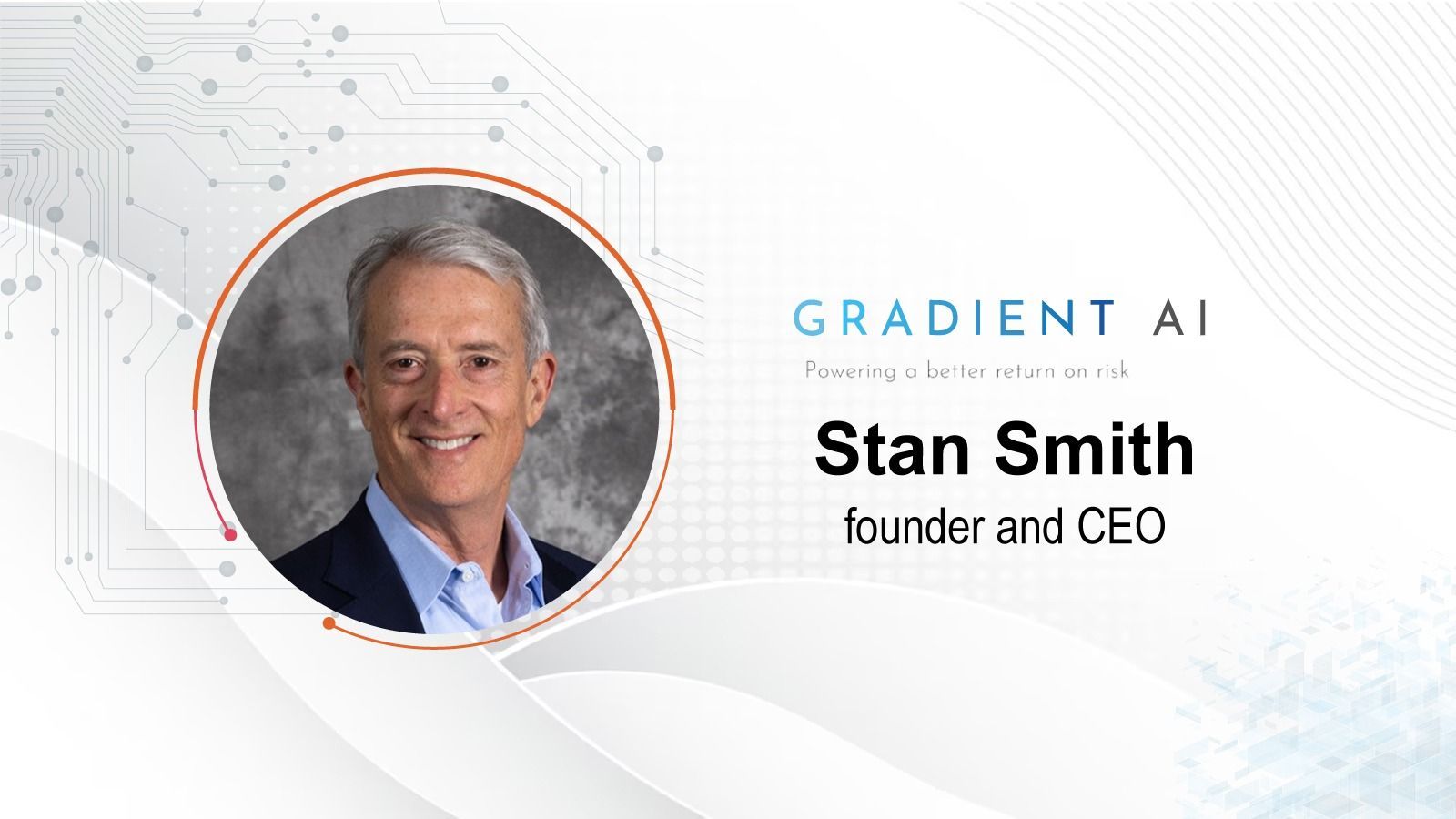CIO Influence Interview with Stan Smith, Founder and CEO of Gradient AI

Stan Smith, Founder and CEO of Gradient AI, shares about the complexity and scale of data in the insurance industry, AI-driven strategy for insurance carriers to improve underwriting and claims operations and more in this Q&A:
Hi Stan, welcome to our CIO Influence Interview Series. Take us through your journey to founding Gradient AI and what it’s like as a SaaS CEO today?
Thank you! My background is in growing AI and technology organizations that address significant business needs, which I have been doing for the past 30 years.
At a previous company, I witnessed first-hand the inefficiencies and mistakes occurring within the insurance industry because of compounding data issues. Insurers were spending an awful lot of time collecting data scattered across siloed business units on paper or in other unstructured digital formats. Underwriting and claims management professionals didn’t have access to the information they needed to make decisions, and they were assessing risk using traditional approaches that have largely been in place for decades, if not centuries.
Determined to address these business challenges, I launched Gradient AI, a SaaS organization focused on applying AI and machine learning technologies to help the insurance industry operate more efficiently and effectively. As a SaaS CEO today, it’s both challenging and rewarding. Every day involves making strategic decisions to drive innovation, managing a talented team, and ensuring we deliver exceptional value to our clients. The dynamic nature of AI technology keeps us constantly adapting and growing.
Gradient AI has been at the forefront of integrating AI and machine learning in the insurance industry. How do you see these technologies evolving in the next five years?
We’re very focused on helping insurers to leverage AI for underwriting and claims processing, and as a result, they are better able to assess risk and take action accordingly.
In the next five years, I see AI and machine learning expanding to become even more integral to the insurance industry. Technologies like large language models (LLMs) and generative AI will accelerate adoption and usability. These advancements will make AI tools more accessible for insurers. For example, to summarize medical records and other documents, and even query vast previously inaccessible knowledge bases, consulting decades of accumulated claims data, medical notes, and outcomes to improve decision-making in their underwriting and claims management operations.
AI will also evolve to provide more predictive and prescriptive analytics, helping insurers make even better decisions faster and more accurately.
What are the key challenges you faced when founding Gradient AI, and how did you overcome them to establish a leading position in the industry?
One of the key challenges I faced and continue to face is overcoming misconceptions about AI. Many potential clients have false beliefs about what can and can’t do. We address this by demystifying AI and demonstrating its practical applications in the insurance sector. It isn’t a black box, but rather a data-driven, trained computer model, which enables insurers to assess risk, make decisions, and take action in a much more informed way than with traditional approaches.
We focus on specific use cases and provide clear proof points through data and results. This pragmatic approach has helped us build trust and establish a strong reputation in the industry.
Given the complexity and scale of data in the insurance industry, how does Gradient AI ensure the accuracy and reliability of its AI models and predictions?
We ensure accuracy and reliability through a contributory data model. This approach involves aggregating data from multiple clients across various systems. By having access to a broader dataset, we can validate our models against diverse information, ensuring they perform well across different scenarios. This not only helps in assessing model accuracy but also in identifying and mitigating biases.
Our industry data lake contains tens of millions of structured and unstructured underwriting and claims records. All of the data is de-identified to ensure anonymity. Beyond the contributory sources, we’ve further enhanced it by adding third-party data sources, such as medical, prescription, and laboratory data, as well as weather, crime, and other demographic data points, and more. We added these additional features that go beyond basic data points because they enable AI models to be more accurate predictors.
Of course, ensuring the security of data is paramount, and Gradient AI is SOC2 compliant and HITRUST certified.
In your experience, what are the essential components of a successful AI-driven strategy for insurance carriers to improve underwriting and claims operations?
The essential components include:
- Clear Objectives: Define what you want to achieve with AI. Is it growth, profitability, or operational efficiency?
- Data Integration: Leverage contributory data models to enhance the robustness of AI predictions.
- Employee Support: AI should assist employees by suggesting actions and streamlining processes, especially in environments with high turnover and distributed workforces.
- Proof Points: Demonstrate the effectiveness of AI through clear, tangible results.
We also think it’s important as an AI solution provider to partner with our clients to ensure they get the maximum value from their AI implementation. Whether that has to do with helping them identify the most pressing business challenges for which AI is well-suited, preparing their data, or proving the value of AI in their operations, we work closely with them to make sure all those needs are fully addressed.
How important are integrations and partnerships in the AI and insurance landscape, and how has Gradient AI approached fostering such relationships?
Integrations and partnerships are critical. We believe AI should be seamlessly integrated into existing workflows, where users don’t even realize it’s there. Our strategy involves deeply embedding our products into partner solutions, enhancing their capabilities and making the AI experience smoother for end-users. We often refer to it as “AI at the point of decision,” since it’s about integrating with the ways our customers already do business rather than requiring their teams to learn new processes or take additional steps. Collaborating with other companies allows us to offer the best solutions because we can leverage each other’s strengths.
What innovations at Gradient AI are you particularly excited about, especially those that might redefine industry standards in the near future?
I’m particularly excited about our work in the next-best-action models. These models use AI to provide straightforward applications for handling complex data quickly. On the underwriting side, they help underwriters by highlighting key episodes of care, allowing for more accurate pricing. On the claims side, they suggest the most efficient ways to handle claims, improving cost efficiency and customer satisfaction. These innovations are set to redefine industry standards by automating mundane tasks and allowing professionals to focus on high-value activities.
Finally, what advice would you give to IT leaders who are looking to leverage AI and ML to drive digital transformation in their organizations?
The insurance industry is 500-years old and understandably the people who work in it are risk-averse. That said, insurers that don’t leverage AI for their businesses will be at a major disadvantage. Other firms will leapfrog over them in much the same way that Uber, Amazon, and Airbnb disrupted entire industries with digital transformation.
I would advise insurers to not procrastinate, as a similar disruption is underway in the insurance industry. They should start by developing a clear vision of the strategic levers they want to move, whether that is to reduce costs, improve the customer experience or offer a new and differentiated service. The objective should be to invest in AI in ways that benefit your business model, to achieve a positive, significant, and sustainable impact on your business.

Stan Smith, founder and CEO of Gradient AI, has been working with AI and technology companies for nearly 30 years. By applying the latest Artificial Intelligence and Machine Learning advancements to the data-intensive insurance industry, Stan founded a company that enables insurers to significantly improve their underwriting and claims operations, resulting in enhanced loss ratios and profitability.
Prior to Gradient AI, Stan held founding or executive-level roles with multiple startup companies including MatrixOne, Agile Software, and OpenRatings. He also led development of several patents including technology that predicts bankruptcies, a global database to improve supplier performance, and technology that enhances performance management through lean initiatives. Stan earned his bachelor’s degree from Dartmouth College.
About Gradient AI
Gradient AI is a leading provider of proven artificial intelligence solutions for the insurance industry. Our solutions improve loss ratios and profitability by predicting underwriting and claims risks with greater accuracy, as well as reducing quote turnaround times and claim expenses through intelligent automation.
Gradient AI is SOC2 compliant and HITRUST certified.
Stay on top of AI trends by subscribing to Advanced Insights, the newsletter for strategies, ideas, and insights on AI in insurance. Delivered monthly to your inbox.
©2024 Gradient AI All rights reserved | Terms of Use | Privacy Policy | Legal Terms


